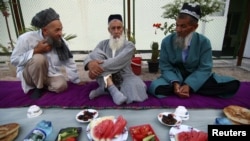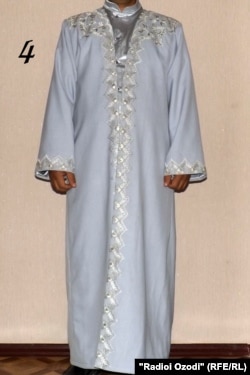It has been said that in diversity there is beauty and strength. But the Tajik authorities, it seems, are more attracted to uniformity.
After introducing uniforms and dress codes for teachers, students, and religious pilgrims in recent years, the powers that be in Dushanbe have set their sights on giving the country's imams a wardrobe makeover.
The State Committee for Religious Affairs announced this week that the design for a new, standard issue, uniform for imams has been agreed upon.
"The uniforms are being tailored now, and the imams will soon have identical outfits," committee head Abdurahim Kholiqov told reporters in Dushanbe on January 14.
The uniform consists of a grey satin shirt, trousers, a turban, and a long powder-blue robe highlighted by traditional white embroidery on the cuffs, lapels, and front trim.
Fashion Designer
The style, created by local female fashion designer Mukarrama Qayumova, has been approved by the state committee as well as the Council of Ulema, the country's highest religious authority.
In an apparent reference to the embroidery, Saidmukarram Abdulqodirzoda, the head of the Council of Ulema, told reporters that the uniforms bear "national characteristics."
"The design encompasses special national characteristics, beautiful color, and beautiful style. The national-religious outfit of the clerics has already passed appraisals and approvals by the council and others," Abdulqodirzoda said.
The state religious committee says the cost and the price of the uniforms have not been determined yet. However, the committee has made it clear that it will cover just 30 percent of the costs, while the rest will be financed by the Council of Ulema and the imams themselves.
Imams have been instructed to send their measurements to the private "Saidjon" sewing factory, which has been contracted to produce the uniforms.
The first batch of tailor-made outfits is expected to be delivered to 426 imams across the country in February. Eventually, all of the country's more than 4,000 mosques -- some of which employ several clerics, including chief and deputy imams -- will be outfitted.
Tajik media has reported that the idea was inspired by a 2013 meeting between Tajik President Emomali Rahmon and some 200 clerics in which all the religious figures wore identical clothing.
If all goes as planned, the new uniforms will arrive just as the state begins issuing monthly salaries ranging from $170 to $315 to mosque imams, depending on their position.
Council of Ulema head Abdulqodirzoda said the decision to provide the wages was made at the request of chief imams.
Mosques are not considered a state agency in Tajikistan, but all official religious bodies are essentially controlled and regulated by state bodies.
In 2011, the country made it compulsory for Tajik pilgrims performing the Hajj to wear special blue-and-white outfits bearing the country's official symbols.
Tajikistan has also reinstated the Soviet-era tradition of school uniforms, although its plan to required teachers to wear specials outfits reportedly failed due to widespread criticism both by teachers and the public.
As a result, the country's Education Ministry, introduced a dress code banning young male teachers from growing beards. Male teachers above the age of 50 are allowed to have beards, but not more than 1 centimeter in length.
The ministry's dress code prohibits female teachers from wearing an Islamic headscarf or the hijab, which is banned in all state institutions.
After introducing uniforms and dress codes for teachers, students, and religious pilgrims in recent years, the powers that be in Dushanbe have set their sights on giving the country's imams a wardrobe makeover.
The State Committee for Religious Affairs announced this week that the design for a new, standard issue, uniform for imams has been agreed upon.
"The uniforms are being tailored now, and the imams will soon have identical outfits," committee head Abdurahim Kholiqov told reporters in Dushanbe on January 14.
The uniform consists of a grey satin shirt, trousers, a turban, and a long powder-blue robe highlighted by traditional white embroidery on the cuffs, lapels, and front trim.
Fashion Designer
The style, created by local female fashion designer Mukarrama Qayumova, has been approved by the state committee as well as the Council of Ulema, the country's highest religious authority.
In an apparent reference to the embroidery, Saidmukarram Abdulqodirzoda, the head of the Council of Ulema, told reporters that the uniforms bear "national characteristics."
"The design encompasses special national characteristics, beautiful color, and beautiful style. The national-religious outfit of the clerics has already passed appraisals and approvals by the council and others," Abdulqodirzoda said.
The state religious committee says the cost and the price of the uniforms have not been determined yet. However, the committee has made it clear that it will cover just 30 percent of the costs, while the rest will be financed by the Council of Ulema and the imams themselves.
Imams have been instructed to send their measurements to the private "Saidjon" sewing factory, which has been contracted to produce the uniforms.
The first batch of tailor-made outfits is expected to be delivered to 426 imams across the country in February. Eventually, all of the country's more than 4,000 mosques -- some of which employ several clerics, including chief and deputy imams -- will be outfitted.
Tajik media has reported that the idea was inspired by a 2013 meeting between Tajik President Emomali Rahmon and some 200 clerics in which all the religious figures wore identical clothing.
If all goes as planned, the new uniforms will arrive just as the state begins issuing monthly salaries ranging from $170 to $315 to mosque imams, depending on their position.
Council of Ulema head Abdulqodirzoda said the decision to provide the wages was made at the request of chief imams.
READ NEXT: Imam's Sex Video Sparks Scandal In Tajikistan
Mosques are not considered a state agency in Tajikistan, but all official religious bodies are essentially controlled and regulated by state bodies.
In 2011, the country made it compulsory for Tajik pilgrims performing the Hajj to wear special blue-and-white outfits bearing the country's official symbols.
Tajikistan has also reinstated the Soviet-era tradition of school uniforms, although its plan to required teachers to wear specials outfits reportedly failed due to widespread criticism both by teachers and the public.
As a result, the country's Education Ministry, introduced a dress code banning young male teachers from growing beards. Male teachers above the age of 50 are allowed to have beards, but not more than 1 centimeter in length.
The ministry's dress code prohibits female teachers from wearing an Islamic headscarf or the hijab, which is banned in all state institutions.

